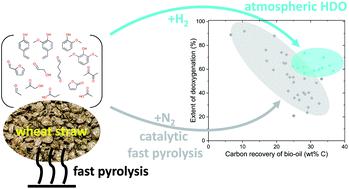当前位置:
X-MOL 学术
›
Sustain. Energy Fuels
›
论文详情
Our official English website, www.x-mol.net, welcomes your
feedback! (Note: you will need to create a separate account there.)
Enhancing bio-oil quality and energy recovery by atmospheric hydrodeoxygenation of wheat straw pyrolysis vapors using Pt and Mo-based catalysts
Sustainable Energy & Fuels ( IF 5.0 ) Pub Date : 2020-02-11 , DOI: 10.1039/c9se01254k Andreas Eschenbacher 1, 2, 3, 4 , Alireza Saraeian 5, 6, 7, 8 , Brent H. Shanks 5, 6, 7, 8 , Peter Arendt Jensen 1, 2, 3, 4 , Chengxin Li 2, 3, 4, 9 , Jens Øllgaard Duus 2, 3, 4, 9 , Asger Baltzer Hansen 3, 4, 10 , Uffe Vie Mentzel 3, 4, 10 , Ulrik Birk Henriksen 1, 2, 3, 4 , Jesper Ahrenfeldt 1, 2, 3, 4 , Anker Degn Jensen 1, 2, 3, 4
Sustainable Energy & Fuels ( IF 5.0 ) Pub Date : 2020-02-11 , DOI: 10.1039/c9se01254k Andreas Eschenbacher 1, 2, 3, 4 , Alireza Saraeian 5, 6, 7, 8 , Brent H. Shanks 5, 6, 7, 8 , Peter Arendt Jensen 1, 2, 3, 4 , Chengxin Li 2, 3, 4, 9 , Jens Øllgaard Duus 2, 3, 4, 9 , Asger Baltzer Hansen 3, 4, 10 , Uffe Vie Mentzel 3, 4, 10 , Ulrik Birk Henriksen 1, 2, 3, 4 , Jesper Ahrenfeldt 1, 2, 3, 4 , Anker Degn Jensen 1, 2, 3, 4
Affiliation

|
Atmospheric hydrodeoxygenation (HDO) of wheat straw fast pyrolysis vapors was studied as a promising route for the production of renewable liquid transportation fuels. The performance of TiO2-supported Pt (0.5 wt%) and MoO3 (10 wt%) catalysts was compared to an industrial Mo-based catalyst using a bench scale reactor operated at atmospheric pressure and up to high biomass-to-catalyst ratios (B:C). Mass and energy balances were complemented by detailed bio-oil characterization including advanced methods such as GC×GC-ToF/MS or -FID and 13C NMR. At 50 vol% H2, all three HDO catalysts effectively reduced the oxygen content of the bio-oils to ∼7–12 wt% (dry basis) compared to a non-catalytic reference (23 wt% O). MoO3/TiO2 was least efficient in conversion of acids (TAN = 28 mg per KOH), while Pt/TiO2 and MoO3/Al2O3 obtained oils with TAN ∼ 13 mg KOH/g (non-catalytic = 66 mg KOH/g). Compared to the TiO2-supported catalysts, the industrial Mo/Al2O3 catalyst produced higher yields of coke at the expense of condensed bio-oil. MoO3/TiO2 performed similar to Pt/TiO2 in terms of deoxygenation and energy recovery of condensed bio-oil, and by increasing the H2 concentration to 90 vol% the energy recovery of bio-oil increased to 39 and 42% at 8 and 10 wt% O (d.b.), respectively. Pt/TiO2 showed the highest selectivity to aliphatics and the lowest coke yields, e.g. the coke yield at B:C ∼ 8 was only 0.6 wt% of fed biomass. This study demonstrates that by using low-pressures of hydrogen and appropriate HDO catalysts, the quality of bio-oil can be improved without severely compromising its quantity (carbon yield) as observed under catalytic fast pyrolysis conditions.
中文翻译:

使用Pt和Mo基催化剂通过麦秸秆热解蒸气的大气加氢脱氧来提高生物油质量和能量回收
麦秸快速热解蒸气的大气加氢脱氧(HDO)被研究为生产可再生液体运输燃料的有希望的途径。TiO 2负载的Pt(0.5 wt%)和MoO 3(10 wt%)催化剂的性能与工业级基于Mo的催化剂进行了比较,使用台式规模的反应器在大气压力和高达高的生物质与催化剂比率下运行(公元前)。质量和能量平衡得到详细的生物油表征的补充,包括先进的方法,如GC×GC-ToF / MS或-FID和13 C NMR。与非催化参比(23 wt%O)相比,在50vol%H 2时,所有三种HDO催化剂均有效地将生物油中的氧含量降低至约7-12 wt%(干基)。MoO 3/ TiO 2转化酸的效率最低(TAN = 28 mg / KOH),而Pt / TiO 2和MoO 3 / Al 2 O 3获得的油的TAN约为13 mg KOH / g(非催化= 66 mg KOH) /G)。与TiO 2负载的催化剂相比,工业Mo / Al 2 O 3催化剂以冷凝的生物油为代价产生了更高的焦炭收率。MoO 3 / TiO 2在缩合生物油的脱氧和能量回收以及增加H 2方面的表现与Pt / TiO 2相似。当浓度达到90 vol%时,在8和10 wt%O(db)下,生物油的能量回收率分别增加到39和42%。Pt / TiO 2对脂肪族化合物的选择性最高,焦炭产率最低,例如在B:C〜8的焦炭产率仅为进料生物质的0.6 wt%。这项研究表明,通过使用氢气的低压和合适的HDO催化剂,可以改善生物油的质量,而不会严重影响其在催化快速热解条件下的数量(碳收率)。
更新日期:2020-02-11
中文翻译:

使用Pt和Mo基催化剂通过麦秸秆热解蒸气的大气加氢脱氧来提高生物油质量和能量回收
麦秸快速热解蒸气的大气加氢脱氧(HDO)被研究为生产可再生液体运输燃料的有希望的途径。TiO 2负载的Pt(0.5 wt%)和MoO 3(10 wt%)催化剂的性能与工业级基于Mo的催化剂进行了比较,使用台式规模的反应器在大气压力和高达高的生物质与催化剂比率下运行(公元前)。质量和能量平衡得到详细的生物油表征的补充,包括先进的方法,如GC×GC-ToF / MS或-FID和13 C NMR。与非催化参比(23 wt%O)相比,在50vol%H 2时,所有三种HDO催化剂均有效地将生物油中的氧含量降低至约7-12 wt%(干基)。MoO 3/ TiO 2转化酸的效率最低(TAN = 28 mg / KOH),而Pt / TiO 2和MoO 3 / Al 2 O 3获得的油的TAN约为13 mg KOH / g(非催化= 66 mg KOH) /G)。与TiO 2负载的催化剂相比,工业Mo / Al 2 O 3催化剂以冷凝的生物油为代价产生了更高的焦炭收率。MoO 3 / TiO 2在缩合生物油的脱氧和能量回收以及增加H 2方面的表现与Pt / TiO 2相似。当浓度达到90 vol%时,在8和10 wt%O(db)下,生物油的能量回收率分别增加到39和42%。Pt / TiO 2对脂肪族化合物的选择性最高,焦炭产率最低,例如在B:C〜8的焦炭产率仅为进料生物质的0.6 wt%。这项研究表明,通过使用氢气的低压和合适的HDO催化剂,可以改善生物油的质量,而不会严重影响其在催化快速热解条件下的数量(碳收率)。











































 京公网安备 11010802027423号
京公网安备 11010802027423号